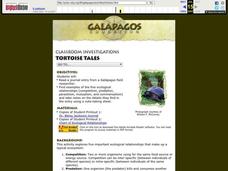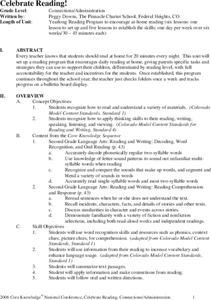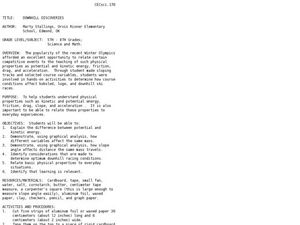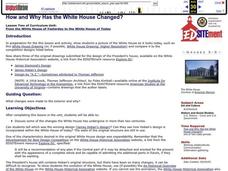Curated OER
How Many Birds Would It Take To Keep A Jackal Alive?
Students examine the role of large families in some animal populations. They work together to complete an activity related to food supply. They discover the relationship between preys and predators.
Curated OER
Tortoise Tales
Students read journal entry from a Gal??pagos field researcher, find examples of five ecological relationships (competition, predation, parasitism, mutualism, and commensalism) and take notes on the details they find in the entry using a...
Learning Games Lab
Nitrogen in Fertilizer
Nitrogen is an essential element for productive farming. An interactive lesson explores the chemical makeup of different fertilizers and their corresponding nitrogen content. The interactive challenges individuals to complete...
Learning Games Lab
Scientific Graph Reading
Interpreting graphs is an essential skill for young scientists. An interactive online lesson gives individuals an opportunity to review the components of a graph and learn to read and interpret the shape of a graph. The lesson includes...
Curated OER
Birds & Caterpillars
In this biology worksheet, students explain the use of camouflage as a defense mechanism. Then they list examples of insects that use camouflage to protect them from predators. Students also identify and name other types of defense...
Curated OER
A Cat-and-Mouse Story
Students view an animated PowerPoint program that teaches possessive vocabulary in Spanish. They review English grammar. Students access high-frequency verbs and additional vocabulary.
Curated OER
An Interdisciplinary Deer and Human Population Study
Students answer the question, "What environmental problems arise due to animal and human overpopulation and what might need to be done to combat these problems?" They play games, graph data and write proposals about the question.
Curated OER
DOWNHILL DISCOVERIES
Students studykinetic energy, friction, drag and acceleration by relating it to the Winter Olympics. In this physical properties lesson students create tracks and determine how the course conditions affect bobsled, luge and...
Curated OER
What If We Run Out?
Young scholars explore the consequences of shrinking habitats and the human impact on wildlife populations. They participate in a game to study the consequences and describe the preservation of animal habitats.
Curated OER
Cypress/Tupelo Swamps
Students study the geologic history of terrain, soils, and drainage patterns. They recognize ecological processes that determine the dynamic nature of habitats. They investigate the influence of human activity on the landscape.
Curated OER
Biogeography
Third graders listen to a teacher led lecture about species living in different parts of the world. They study how the species spread to different parts of the world and examine the concept of dispersal. As a class, 3rd graders...
Curated OER
Celebrate Reading!
Students improve their reading skills by completing at home reading assignments. In this reading skills lesson, students participate in a bulletin board competition to help them track and progress with their daily reading. Students...
Curated OER
Tropical Deforestation
In this natural resources worksheet, students read a 1-page article about tropical deforestation and then respond to 11 short answer questions. Students then write a memo on deforestation and select 1 of 3 assessment activities to complete.
Curated OER
Land Use Issues
Students participate in activities in which they examine land use. They examine the types of animals in a surrounding and how they blend in with the environment. They also examine food resources.
Curated OER
Household Pests
Sixth graders discover the various habitat requirements for assorted household pests from ants to wasps. They conduct various activities including researching the life cycles moths, cockroaches, and mosquitoes
Curated OER
Downhill Discoveries
Students are involved in hands-on activities to determine how course conditions affect bobsled, luge, and downhill ski races.
Curated OER
Art Reflecting Life
Have your young television viewers discuss popular shows among their peers. After choosing one show to analyze, middle and high schoolers read about the 2007-2008 network television lineup with the New York Times article "Gauging...
Curated OER
Water's Edge Café
Learners observe water birds feeding at a local wetland, record what they see, and construct an appropriate menu for a "Waterfowl Cafe." They also play a "flocking" game.
Curated OER
How and Why Has the White House Changed?
Students examine changes the White House has undergone in the past two centuries. They view and discuss online images and designs, compare diagrams, read information from various websites, and answer discussion questions.
Learning Games Lab
Nitrogen in Pollutants
Responsible farming is important for maintaining natural resources. Eager scientists complete a WebQuest to explore what happens to nitrogen when it enters the soil. They learn about the chemical makeup of nitrogen-based molecules...
Curated OER
How and Why Has the White House Changed?
Students view original design drawings of the White House and discuss ways it has been changed. They view images of the white house from specified dates and discuss the changes that were made from one to the other, as well as reasons for...
Curated OER
The Circle of Life: Food Chain
Students develop a flow chart using computer software to show a food chain combination. In this food chain instructional activity, students are first read The Great Kapok Tree by Lynne Cherry, then they create a story map of the...
Curated OER
Night Hike
Students explore Upham Woods at night and investigate about the special adaptations of nocturnal animals. They identify three nocturnal animals and how they are adapted to the night. Students explain what night vision is and how it works.

























